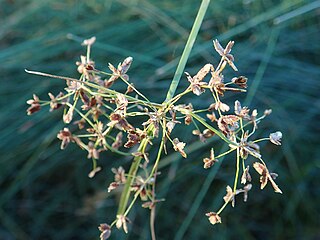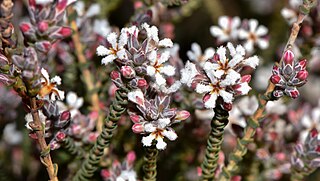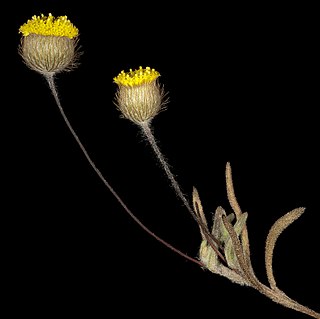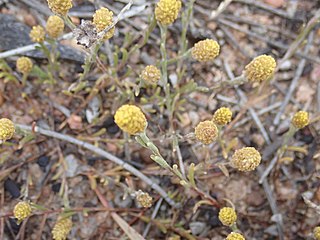
The National Herbarium of Victoria is one of Australia's earliest herbaria and the oldest scientific institution in Victoria. Its 1.5 million specimens of preserved plants, fungi and algae—collectively known as the State Botanical Collection of Victoria—comprise the largest herbarium collection in Australia and Oceania.

Solanum chippendalei is a small fruiting shrub in the family Solanaceae, native to northern Australia. It is named after its discoverer, George Chippendale. The fruits, known as "bush tomatoes", are edible and are an important indigenous food, and the aborigines who use them broadcast the seed for later harvesting.

Aphanopetalum resinosum, known as the gum vine, is a small plant growing in rainforest or eucalyptus forest in eastern Australia, from north-east Victoria, through New South Wales and north to Queensland.

Nymphoides crenata, commonly known as wavy marshwort, is an aquatic perennial herb of the family Menyanthaceae endemic to Australia, found in all mainland states and the Northern Territory

Cyperus concinnus is a sedge of the family Cyperaceae that is native to Australia, and found in New South Wales, Queensland, the Northern Territory, South Australia, Victoria and Western Australia.
Cyperus crispulus is a sedge of the family Cyperaceae that is native to Australia and found in Western Australia, and the Northern Territory.

Chenopodium spinescens is a species of plant in the family Amaranthaceae and is endemic to all mainland states and territories of Australia where it is known as Rhagodia spinescens.

Velleia glabrata is an annual herb in the family Goodeniaceae, which is native to all mainland states and territories of Australia with the exception of Victoria. It grows on sand and clay, flowering from June to October.

Leucopogon sprengelioides is an erect shrub in the family Ericaceae found in Western Australia, where it grows on granite outcrops and hill, ridges and breakaways and on coastal limestone. It grows to a height of 0.2 - 0.8 m and its white flowers may be seen from March to April or July to November.

Rumex vesicarius, also known as Ruby dock, or bladder dock, is a species of perennial flowering plant in the family Polygonaceae. According to Plants of the World Online, Rumex vesicarius is native to tropical and temperate Asia, Africa, and Western Australia. However, the Council of Heads of Australasian Herbaria asserts that within Australia it is naturalised in Western Australia, the Northern Territory, South Australia, Queensland and New South Wales.

Waltheria virgata is a species of flowering plant in the mallow family, Malvaceae, that is found in the north of Western Australia, and in the Northern Territory.

Dampiera dentata is a plant in the family Goodeniaceae, native to Western Australia and the Northern Territory.

Poa drummondiana is a perennial herb in the Poaceae family.

Podolepis canescens is a herb in the Asteraceae family, which is found in South Australia, the Northern Territory, New South Wales and Victoria. PlantNet also states that it is found in Western Australia, but FloraBase states that the name is misapplied in Western Australia, based on Jeanes (2015).

Asteridea athrixioides is a herb in the Asteraceae family, which is endemic to Australia, and found in Western Australia, South Australia and Victoria. It was first described in 1853 by Otto Sonder and Ferdinand von Mueller as Panaetia athrixioides, who described it from specimen(s) collected in the Port Lincoln district. In 1980, G. Kroner assigned it to the genus, Asteridea, giving it the name Asteridea athrixioides. It is an annual herb, growing on calcareous, sandy or clay soils to heights of from 5 cm to 20 cm. Its yellow flowers may seen from July to November on saline on allvial flats, rocky hills and undulating plains.

Portulaca filsonii is a plant in the Portulacaceae family, endemic to central Australia in the Northern Territory.

Peplidium foecundum is a plant in the Phrymaceae family, native to South Australia, Queensland, the Northern Territory and New South Wales.

Hybanthus floribundus is a plant in the Violaceae family, found in southern Western Australia, southern South Australia, Victoria and southern New South Wales.

Calocephalus sonderi is a plant in the family Asteraceae, found in South Australia, Victoria, Queensland and New South Wales.

Triglochin muelleri is a species of flowering plant in the family Juncaginaceae, first described by Franz Georg Philipp Buchenau in 1903, and native to Western Australia and South Australia.






















